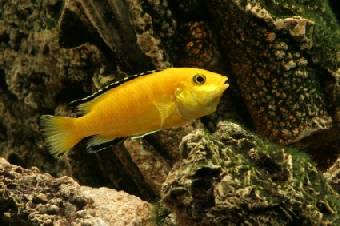Labidochromis caeruleus (Electric Yellow Cichlid)

Labidochromis caeruleus belongs to the family Cichlidae. It is commonly referred to as the electric yellow cichlid due to its brilliant yellow coloration. The dorsal fin is black.
They are from Lake Malawi in Africa, which is why this species is lumped together with the group of fishes that are often referred to as African cichlids or Lake Malawi cichlids.
This is a popular cichlid for the home aquarium because it isn't as territorial or aggressive as some of the other cichlids and also because of its brilliant color. They reach an adult size of approximately 3-4 inches (7.5-10 cm). You will need to provide lots of rockwork and caves in their aquarium. In their natural habitat they are rock-dwelling fish (known as mbuna for their rock-dwelling behavior as opposed to open water cichlids).
Electric yellows are peaceful cichlids that shouldn't be kept in the same aquarium with other aggressive species of cichlids. Keeping a group of about 6 electric yellows is best as long as you have the room in your aquarium. They will do best if you have provided plenty of ceramic caves and rocks in your tank.
They do best in alkaline water (pH of between 7.5-8.0) of medium hardness. They need a water temperature of between 72-78°F (22-26°C).
Electric yellow cichlids will eat most aquarium fare, flakes, pellets, freeze-dried, frozen, and live foods. They are omnivores, eating both animal and plant-based foods.
Sexing them isn't too difficult because the male typically has more black on his dorsal fin than the female does. Unlike a lot of other cichlids, Labidochromis caeruleus don't pair up for life. With these cichlids, the male finds any available female to mate with. Often a partial water change will encourage spawning.
Like all cichlids from Lake Malawi, Labidochromis caeruleus are maternal mouthbrooders. What this means is that the mother incubates the eggs in her mouth until they hatch. For a time she will also hold the fry in her mouth to protect them. During this time the mother fish won't eat. Sometimes the mother will hold the fry in her mouth for up to a month.
After the fry hatch and are swimming freely, the fry can be fed commercial food for egg laying fry, newly hatched brine shrimp, and powdered food for fry.
